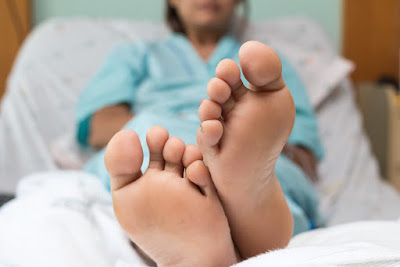Dekubitus sores also known by the term wound press (pressure ulcer/bedsores). Dekubitus wound is a wound on the surface of the skin which often appear in patients who experience obstacles in movement (mobility). When you or members of your family are a patient tirah baring (bed rest), this will probably be wound problems often encountered. To find out more information, read on the explanations below.
 |
| Preventing and Treating of wounds on the patient's Tirah Dekubitus Baring |
Why can wounds dekubitus tirah baring on the patient?
There are some conditions under which patients should undergo treatment while the total rest period. The treatment called tirah baring is usually experienced by patients who are paralyzed, comatose, has limited movement because of certain medical conditions, and others. Those who undergo treatment tirah baring indeed more vulnerable dekubitus was injured.
This is caused by the continual emphasis on skin and soft tissue against hard surfaces, such as benches, wheelchairs, or a bed in a long period of time, especially in one position. This emphasis led to the reduced blood supply to the area, so the area will suffer damage or injuries.
Know the risk factors to the emergence of luka dekubitus
Immobilitas, especially in patients with movement disorders, for example because of the lame
Spend more time in bed or in a wheelchair
The vulnerable skin scars especially on old age
Nutrients are not met, including the lack of fluid intake
History of diabetes mellitus
Dekubitus sores symptoms
These wounds are generally formed on the skin area that covers the bone. Periodic checking from head to toe especially in the following areas:
The heel and ankles
The knee
The back
The spine and coccyx
However, in any patient, the symptoms dekibitus sores can be different. This depends on the stage of the emergence of the cuts and whether the proper handling of the prospectus or not. Here are the characteristics of the wound on the patient's stage appearances in the tirah baring according to:
Stage 1: redness of the skin or the skin discoloration occurs varies. In addition, the skin may feel warm, pain, and kinda hard when touched.
Stage 2: appearing on the surface of the skin wound with skin color pink-reddish, it could also be accompanied by blisters.
Stage 3: the wound is getting in, it could be accompanied by pus.
Stage 4: wounds that appear may have very deep, up to damage the muscles and bones. Might formed dead networking until color blackish.
Final stages: yellow or green Wound with a layer of Brown pus in it. At this stage if the layers are wet, immediately control the wound to the doctor!
The guides took care of the wound and prevent dekubitus
Do not rub the skin and wounds too hard while bathing.
Use of protective Moisturiser creams and skin.
Keep so that the surface is always clean and dry.
Note the nutritional intake of the patient, especially cukupi protein and calorie needs.
Use a pedestal bed containing jelly or air so that the air circulation more smoothly and not humid.
Use the sockets on the area of the buttocks to absorb humidity.
Use the base form of a pillow or pillow case on areas that come into contact with a bed (generally the area of the buttocks, coccyx, heels, and calves).
Never drag the patient to change the position (e.g. from a bed to a wheelchair) because this can cause sores on the skin's surface.
Change the position of each 1-2 hours to relieve pressure or friction on one part of the course.
Fixed control doctor regularly for further treatment.
Thankyou for visiting this site and reading Preventing and Treating of wounds on the patient's Tirah Dekubitus Baring
